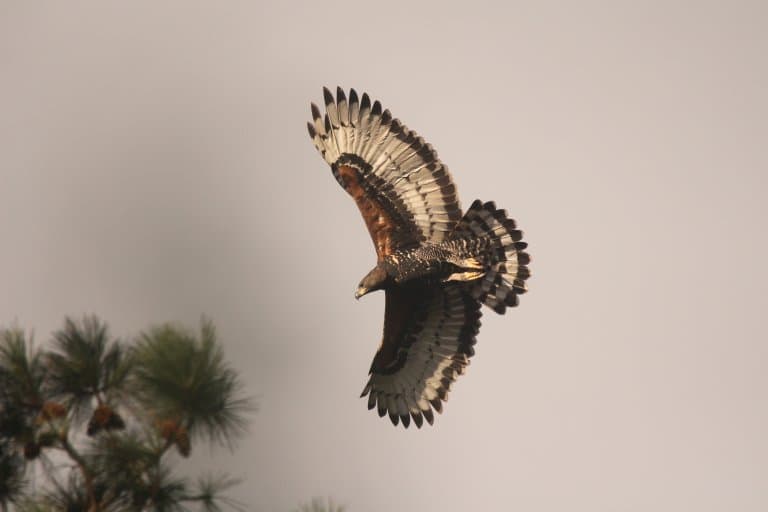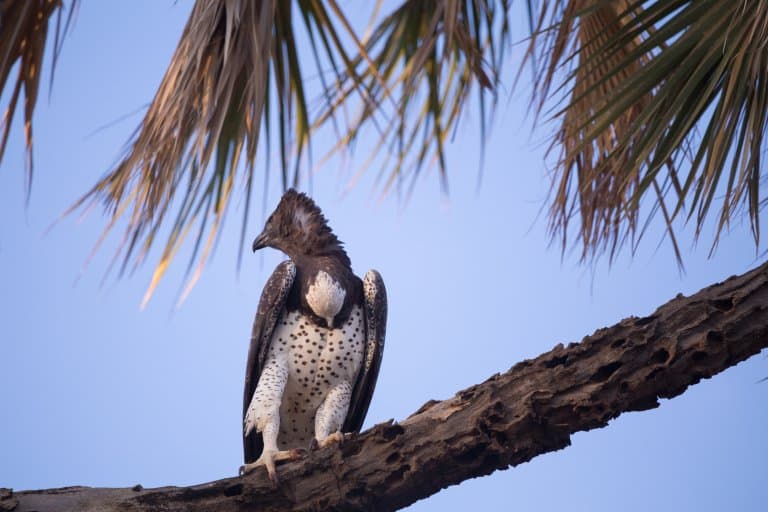Crowned Eagle Profile
Of all the things that used to kill our ancient ancestors, there are very few remaining.
For better or worse (it’s mostly worse), we’ve killed off almost anything that’s a danger to us. In the class of birds, very few remain as a threat to a fully grown human.
Some, though, will still take a small one, if they can get their talons on them. And one, a primate specialist, has been doing it for millions of years. Meet the crowned eagle.
The crowned eagle is also known as the African crowned eagle, or the crowned hawk-eagle, and is a large bird of prey found in Central and Southern Africa.

Crowned Eagle Facts Overview
| Habitat: | Westlands, savanna, forest |
| Location: | Central and Southern Africa |
| Lifespan: | 14 years |
| Size: | Up to 1m (3ft) long |
| Weight: | 4.7kg (10.4lb) |
| Colour: | Grey to black, sometimes dappled brown |
| Diet: | Mammals |
| Predators: | Humans |
| Top Speed: | Unknown |
| No. of Species: | 1 |
| Conservation Status: | Near Threatened (IUCN) |
Like most raptors in Africa, crowned eagles are non-migratory and inhabit a fixed location, mainly dense woodlands and rainforests.
Crowned Eagles are at the top of their food chain. They are opportunistic feeders, but usually, a population will have its preferred prey item and focus primarily on that. Over 90% of it’s diet is mammals, and often that preference is primates.
While mostly monkeys, they’re renowned hunters of small humans, too. This is a relationship that dates back millions of years to our prehistoric ancestry species.
Their reputation isn’t entirely fair, but it has led to persecution, and forest destruction promises to make things worse for the species across their range.
Yet, this is a bird to whom we owe so much as a worthy adversary throughout our evolution, so we should be doing more to help it.
Interesting Crowned Eagle Facts
1. They’re both forest and savanna hunters
For a bird that’s so well specialised, these are remarkably adaptable animals. They have a wide range of food options, though forest populations tend to specialise in one type of mammal over another.
They’re equally adept in the savanna as they are in the forest, with shortened wings for their size, allowing them to navigate through forest canopies swiftly.
Still, these are large birds, with a wingspan of up to 2 meters across, and they will ferociously protect their nests, even readily attacking humans that get too close.
Due to ecological and behavioral similarities, they are considered to be the African counterpart of the Harpy Eagle, which is also bold and powerful raptor.

2. They’re Apex Predators
These are very large raptors, and there’s nothing really that tops them in their world.
They have unusually large talons and strong legs and are the most powerful raptor in Africa – only behind the harpy eagle as most powerful living bird of prey.
They are capable of taking out prey weighing up to 30kg, they’re plenty big enough to be a concern to farmers in some regions.
In one study from a South African population, the adorable rock hyrax was the preferred prey of the crowned eagle, but when those were thin on the ground, the eagles moved more towards vervet monkeys. Around 6% of the prey was made up of domestic livestock, and a handful of cats, though in general, eagles seem to stay away from pets.
The trouble is, they have a reputation for killing our loved ones, so in some regions, they’re likely to be persecuted. And that’s a shame, because not only does it appear to be an unfair reputation, but these eagles and their ancestors likely drove us towards the societies we live in now. 1
3. They are vocal
The crowned eagle is an extremely talkative bird with a noisy, undulating show flight. They will often call all year round with loud whistles, mostly related to breeding.
Males will perform fairly elbaorate rise-and-fall displays over the rainforest canopy. This includes diving from heights of 3,000 feet with loud shrills.
Females will display less often, but pairs can come together mutually to display and breed. They can interlock talons and ‘fall from the sky’ together for a short period in these displays.
4. Crowned eagles have prolonged breeding cycles of any bird
This is common for raptors in the tropics, but these cycles mean they breed once every couple of years. This is because the chicks have a nesting period of 9-11 months.
They build some of the largest nets of any eagle, some measuring up to 8ft (2.5m) across. These massive nests are built in the forks of the tallest trees in the forest, high above the ground.
5. They show us how life used to be
In 1925, the fossil remains of a human child gave us the earliest evidence of bipedal locomotion in humans. But this wasn’t a modern Homo sapiens, it was our ancient cousin-possibly-ancestor Australopithecus africanus.
This child was just cutting teeth, and so is estimated to have been 3.3 years when he died. While there’s nothing particularly unusual about the death of an infant almost 3 million years ago, what stands out is that the poor kid looks to have been killed by an eagle.
While this particular eagle species is unknown, it’s very possible that the killer could have been a crowned eagle, as the family is present in the fossil record as far back as 50 million years ago.
More than this, recent investigations into the nature of the bone damage – specifically, the way the eyes were pecked out – are chillingly similar to the way crowned eagles are known to eat monkeys: eyes first.
This discovery represents not only an important turning point in human evolution, but a horrifying example of the dangers of life in a prehistoric garden before human dominance over birds rounded off all the sharp edges of our world.
Still, our species is not completely out of the woods. 2

6. They may be why we’re social
Just after the dinosaurs were mostly wiped out, mammals were suddenly able to run around on the ground without the guarantee of predation. They radiated out and diversified, and where predatory terrestrial dinosaurs once existed, mammals started to fill the niches.
Dangerous predatory mammals (and the remaining terrors like crocs and snakes) soon threatened smaller terrestrial mammals, who subsequently decided it would be safer up in the trees. But what they hadn’t realised is that some of the dinosaurs survived, as birds, and were up there doing what therapods had done for 200 million years: killing mammals.
It’s thought that social grouping in primates may have originated as a way of helping one another detect these predators early, leading to increased grouping numbers, and increased diversity among species sharing these groups.
Crowned eagles, in many regions, are considered specialist monkey killers, and they seem to have more luck when those monkeys are all grouped as a single species.
It’s harder to get past the guards when monkeys from different species are all on the lookout together, suggesting they are continuing an ancient selective pressure on primates to get along.
7. They may even be why we’re bigger
This same selective pressure has been put forward as a hypothesis for why humans and other primates evolved to grow larger.
While a large, warm-blooded animal requires a huge amount of regular nutritional input to maintain, the benefit is that we don’t get mauled by birds as much.
This is one of the reasons herbivorous dinosaurs grew to such epic proportions. Once you’re huge, things tend to leave you alone. 3
8. They still eat people
You might have felt some relief that this attack on the young boy 2.8 million years ago was a thing of the past. But there are some worrying stories with decent credibility detailing the exact same thing happening in the modern world too.
Several credible reports of eagle attacks on children in Ethiopia have been recorded, and the skull of a human child was found inside a crowned eagle’s nest in South Africa.
These birds are not only dinosaurs, they’re dinosaurs that survived the catastrophic event that killed off all the other dinosaurs.
Their predatory success on human children is a stark reminder that we are simply another animal in the ecosystem, and any animal small enough is prey for something bigger. 4
9. But they’re in decline
Understandably, human populations don’t take kindly to eagles eating their children, and for this reason, as well as many others, the birds are persecuted across up to 90% of their range.
Their populations are declining, and they’re now listed as Near Threatened, though this is mostly in conjunction with deforestation.
Like many other bird species, they also lose a lot of individuals to collisions with human structures and electrocution from power lines.
They’re also hunted for arrow fletchings, as food, for witchcraft, and ornaments.

10. More should be done to slow this trend
While a lot of the remaining habitats for these formidable birds exist within protected areas, there’s very little going on to specifically help them.
More protected land should be sought, as well as considerations around upgrading electrical networks to raptor-safe designs, and deeper monitoring of the species overall. If some of these approaches could be implemented, we may be able to catch the species’ decline and reverse it before it reaches dangerous levels. 5
Crowned Eagle Fact-File Summary
Scientific Classification
| Kingdom: | Animalia |
| Phylum: | Chordata |
| Class: | Aves |
| Order: | Accipitriformes |
| Family: | Accipitridae |
| Genus: | Stephanoaetus |
| Species: | Stephanoaetus Coronatus |
Fact Sources & References
- Shane C. McPherson (2015), “Diet of the crowned eagle (Stephanoaetus coronatus) in an urban landscape: potential for human-wildlife conflict?”, Springer Link.
- Norbert J. Cordeiro (2008), “Behaviour of Blue Monkeys (Cercopithecus mitis) in the Presence of Crowned Eagles (Stephanoaetus coronatus)”, Karger.
- W. Scott McGraw (2006), “Primate remains from African crowned eagle (Stephanoaetus coronatus) nests in Ivory Coast’s Tai Forest: Implications for primate predation and early hominid taphonomy in South Africa”, Wiley Online Library.
- Tim Low (2017), “Eagles and Human Babies”, Australian Geographic.
- Crowned Eagle (2018), “Crowned Eagle”, IUCN Red List.
